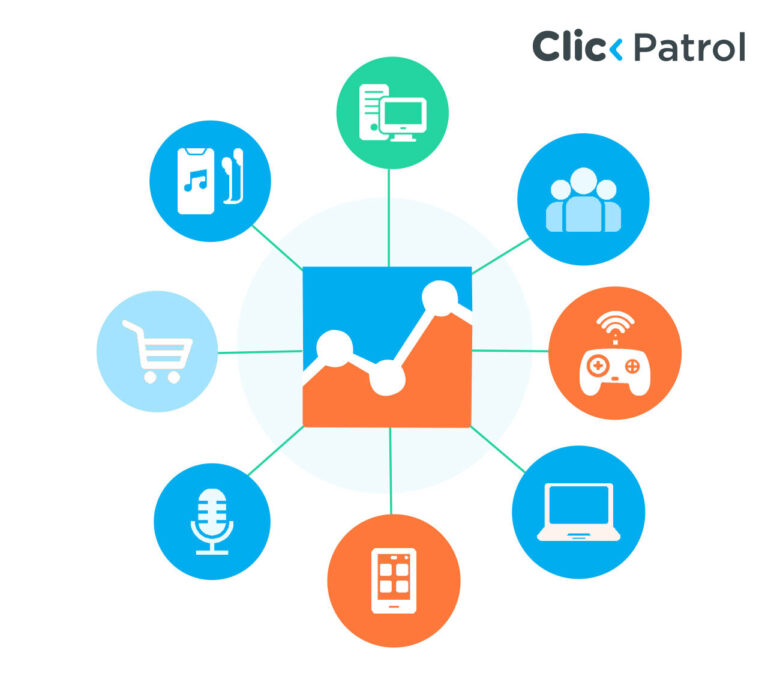
How Clickpatrol Protects Content on Websites from Copyright Infringement Bots
Abisola Tanzako | Dec 18, 2024

Table of Contents
- What are copyright infringement bots?
- Why do we have copyright infringement bots?
- How does copyright infringement operate?
- The effects of copyright infringement bots.
- How ClickPatrol guards against copyright infringement bots.
- Benefits of using ClickPatrol for copyright protection.
- The future of copyright protection in a bot-driven world.
- FAQs.
Copyright violations have grown more complicated due to the rapid expansion of digital content across platforms. Businesses and content providers are increasingly susceptible to bots replicating, duplicating, and spreading their work elsewhere when they publish it online.
A subset of harmful bots, known as copyright infringement, search the internet, scrape content, and duplicate it on unapproved sites frequently to make money.
In addition to affecting the income of content producers, this compromises the audience’s trust in the brand. This article will explain copyright infringement bots, their workings, and how sophisticated programs like ClickPatrol completely defend against these online dangers.
What are copyright infringement bots?
Automated programs known as “copyright infringement bots” are designed to locate, duplicate, and spread copyrighted digital information online. They replicate or disseminate content on unapproved websites, including pictures, articles, movies, and music. The main goal of these massively operational bots is to make money off of plagiarised or pirated content.
Why do we have copyright infringement bots?
Below are some of the motivations behind copyright infringement bots:
- Revenue generation: To increase traffic and ad revenue, copyright infringement bots frequently replicate excellent material and post it on websites that run advertisements.
- Counterfeit brand promotion: Bots can be used to distribute copyrighted content or imitate well-known companies, leading consumers to fraudulent websites or fake goods.
- SEO manipulation: Bots try to lower the original creator’s SEO ranks by copying content across several websites, which directs consumers to pirated versions.
- Competitor sabotage: Several businesses employ infringement bots to steal intellectual property or proprietary content to gain a competitive edge or lower the original creator’s search engine visibility.
These reasons highlight the various malicious intents that underlie copyright infringement bots, which can result in monetary losses, harm reputations, and make brand protection initiatives more difficult.
How does copyright infringement operate?
Copyright infringement bots use various methods to extract copyrighted content without the owner’s consent. The complexity and sophistication of these techniques vary; some bots are simple to identify, while others are to get past conventional anti-bot filters. They work by:
- Web scraping: Most copyright infringement bots replicate text, photos, and videos from websites. They scrape whole articles or high-resolution media assets using advanced crawling algorithms and upload them to other websites without credit.
- Automated downloads of pictures and videos: These bots focus on the image and video content often shared on websites and social media platforms. After downloading media files, they either alter them to avoid copyright detection or repost them on unapproved websites.
- Deep copying of website structures: Certain bots reproduce entire websites by replicating their layout, code, and media assets, mimicking their structure and content. These fake websites may mislead users into thinking they are getting authentic content from the original author.
- Getting around detection: Advanced infringement bots can avoid detection systems using different IP addresses, VPNs, and proxies. They conceal their source and traffic patterns, evading conventional anti-bot detection techniques, which makes it challenging for content owners to detect them.
The effects of copyright infringement bots.
Copyright infringement bots have a wide-ranging effect on companies investing heavily in digital marketing, brand development, and individual content producers. Among the principal effects are:
- Loss of revenue: Businesses and authors lose some of their potential revenue when unauthorized parties unlawfully reproduce and profit from copyrighted information. This covers licensing fees, product sales, and advertising revenue.
- Brand dilution: When copyrighted content is posted on unapproved websites, the exclusivity and validity of the original brand are diminished. As a result, a brand’s reputation may suffer, and audiences may need help trusting it.
- SEO damage: “Duplicate content” problems by bots that replicate material across several websites, which can lower the original content’s search engine exposure. When search engines identify duplicate content, it becomes more difficult for potential buyers to locate authentic content, frequently resulting in penalties for the original creator’s SEO rating.
- Intellectual property theft: Businesses’ intellectual property is at stake when bots steal their proprietary research, product specifications, or content. This is particularly harmful in sectors like technology and media that rely significantly on proprietary knowledge.
How ClickPatrol guards against copyright infringement bots.
ClickPatrol is a sophisticated fake ad and bot detection tool made to find and stop malicious bot activity on online sites. While ClickPatrol’s primary goal is to combat fake ads, it is also effective in protecting against copyright infringement bots through its multi-layered, AI-driven defense system. Here’s how ClickPatrol helps:
- Live bot detection: With algorithms that examine patterns of behavior to distinguish between real people and bots, ClickPatrol’s AI-powered technology continuously scans website traffic for indications of bot activity. By quickly identifying bots trying to scrape, download, or copy content, its real-time detection tools can notify site owners and take preventative action.
- Analysis of behavior: ClickPatrol analyses visitor behavior to identify odd trends, including frequent requests, fast page scrolling, and downloading attempts. Because these actions usually signal bot activity, ClickPatrol can prevent infringement bots from replicating or disseminating unauthorized content.
- Geo-filtering and IP address blocking: With ClickPatrol’s IP-based banning feature, website owners may stop suspicious IP ranges linked to well-known bot networks from visiting their websites. Among these is geo-filtering, which limits traffic from regions known for bot activity, providing additional protection against infringement bots.
- Machine learning algorithms for adaptive defense: ClickPatrol’s machine learning models constantly learn and adjust to new bot strategies in response to fresh data inputs. Their adaptive feature allows infringement bots to be successfully discovered and banned.
- Fingerprinting of devices and users: ClickPatrol uses fingerprinting techniques to find patterns specific to bots by examining device and user-agent information. By matching these patterns to recognized bot signatures, ClickPatrol successfully filters out bots trying to impersonate real users.
- Watermarking content and encrypting data: ClickPatrol enables watermarking digital assets and offers data encryption options for further security. This guarantees that the encrypted or watermarked versions can assist in identifying and tracking unauthorized usage, allowing for quicker copyright enforcement even if bots can scrape content.
Benefits of using ClickPatrol for copyright protection.
ClickPatrol provides several benefits to companies and content producers who want to safeguard their intellectual property:
Improved revenue protection: ClickPatrol helps companies protect their revenue streams by stopping copyright infringement bots from unlawfully distributing and duplicating information. This maintains ad revenue and subscription fees while ensuring content monetization initiatives reach real audiences.
- Enhanced brand integrity: ClickPatrol’s sophisticated detection capabilities shield trademarks from unlawful use, maintaining their reputation, uniqueness, and worth in the digital marketplace. ClickPatrol also helps maintain a brand’s authenticity by preventing counterfeit sites and content duplication.
- Improved search engine optimization: ClickPatrol prevents bots from generating duplicate content, promoting improved SEO results by maintaining the visibility and authority of original material. By preventing content theft, authors can maintain higher search ranks by lowering their risk of SEO penalties.
- Lower risks of legal and compliance issues: By allowing companies to monitor and manage their digital assets, ClickPatrol lowers the possibility of legal action stemming from copyright violations or intellectual property theft. This proactive approach to content protection reduces legal risks and streamlines copyright enforcement.
- Detailed reporting and analysis: ClickPatrol’s reporting capabilities help businesses comprehend the scope and type of copyright infringement efforts. These capabilities offer comprehensive insights into bot behavior.
The future of copyright protection in a bot-driven world.
The threat of copyright infringement bots is expected to increase as bot technology develops, necessitating the adoption of increasingly advanced defense tactics by companies and content producers. While blockchain technology may contribute to copyright protection by establishing verifiable records of original material ownership, artificial intelligence (AI) and machine learning will remain crucial in detecting and stopping these bots.
Companies and producers must stay current on the newest methods and technologies for bot detection. With their flexible, multi-layered approach to bot defense, solutions like ClickPatrol will probably continue to be crucial in the battle against copyright infringement bots.
FAQs.
Q. 1 Can ClickPatrol detect advanced bots that try to evade standard filters?
Yes, ClickPatrol’s real-time monitoring systems and adaptive machine-learning algorithms are made to identify even the most complex bots that might elude conventional bot filters. Over time, its AI engine adjusts to new dangers by learning from bot behavior.
Q. 2 Does ClickPatrol support IP blocking to keep bots away?
Yes, ClickPatrol enables IP-based blocking, enabling users to block IP addresses and ranges known to be connected to bots. Additionally, it has geo-filtering capabilities, which block traffic from areas with a lot of bot activity.
Q. 3 How does ClickPatrol protect images and videos from copyright infringement?
ClickPatrol provides sophisticated image and video content detection and blocking for bots. It can also facilitate encryption and watermarking for critical digital assets to secure them further, making tracking and preventing unauthorized use easier.





